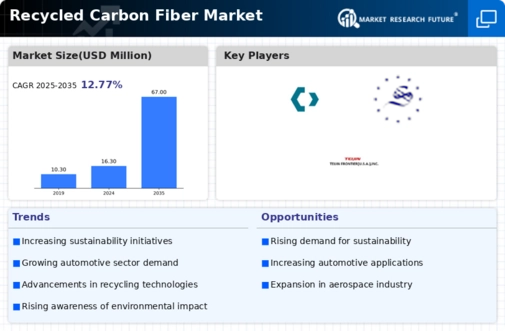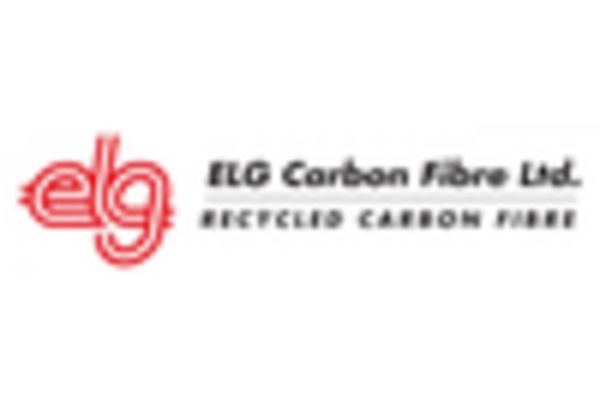-
EXECUTIVE SUMMARY 15
-
MARKET ATTRACTIVENESS ANALYSIS 17
- GLOBAL RECYCLED CARBON FIBER MARKET, BY TYPE 18
- GLOBAL RECYCLED CARBON FIBER MARKET, BY END-USE INDUSTRY 19
- GLOBAL RECYCLED CARBON FIBER MARKET, BY REGION 20
-
MARKET INTRODUCTION 21
-
DEFINITION 21
-
SCOPE OF THE STUDY 21
-
MARKET STRUCTURE 21
-
RESEARCH METHODOLOGY 22
-
RESEARCH PROCESS 22
-
PRIMARY RESEARCH 23
-
SECONDARY RESEARCH 24
-
MARKET SIZE ESTIMATION 25
-
TOP-DOWN AND BOTTOM-UP APPROACH 25
-
FORECAST MODEL 26
-
LIST OF ASSUMPTIONS 27
-
MARKET DYNAMICS 28
-
INTRODUCTION 28
-
DRIVERS 29
- INCREASING DEMAND FOR LIGHTWEIGHT MATERIAL IN AUTOMOTIVE AND AEROSPACE AND
- DEMAND FOR HIGH PERFORMANCE AND COST-EFFICIENT CARBON FIBER 29
- ENVIRONMENTAL SAFEGUARDING BY WASTE REDUCTION 30
-
DEFENSE INDUSTRIES 29
-
RESTRAINTS 31
- PREFERENCE FOR VIRGIN CARBON FIBERS IN HIGH-END APPLICATIONS 31
-
OPPORTUNITIES 31
- RISING ADOPTION OF RECYCLABLE AND ECO-FRIENDLY MATERIALS IN DIVERSE END-USE INDUSTRIES 31
-
CHALLENGE 32
- TECHNOLOGICAL CHALLENGES 32
- LACK OF AVAILABILITY OF COMPOSITE WASTE 32
-
MARKET FACTOR ANALYSIS 33
-
SUPPLY CHAIN ANALYSIS 33
- RAW MATERIAL 33
- RECYCLED CARBON FIBER MANUFACTURERS 33
- DISTRIBUTION CHANNELS 34
- END USERS 34
-
PORTER’S FIVE FORCES MODEL 35
- THREAT OF NEW ENTRANTS 35
- BARGAINING POWER OF SUPPLIERS 36
- THREAT OF SUBSTITUTES 36
- BARGAINING POWER OF BUYERS 36
- RIVALRY 36
-
PRICING ANALYSIS, BY REGION, USD/KG (2018–2020) 37
-
IMPACT OF COVID-19 ON THE GLOBAL RECYCLED CARBON FIBER MARKET 37
- IMPACT OF COVID-19 OUTBREAK ON THE SUPPLY CHAIN 37
- NUMBER OF COVID CASES TILL JUNE 2020 38
- MAJOR GOVERNMENT POLICIES TO COUNTER THE IMPACT OF COVID-19 39
- QUALITATIVE ANALYSIS ON CHANGE IN DEMAND FROM END-USE INDUSTRY 42
-
GLOBAL RECYCLED CARBON FIBER MARKET, BY TYPE 43
-
INTRODUCTION 43
-
NON-WOVEN MATS 45
-
MILLED CARBON FIBER 47
-
CHOPPED CARBON FIBER 49
-
GLOBAL RECYCLED CARBON FIBER MARKET, BY END-USE INDUSTRY 51
-
INTRODUCTION 51
-
AUTOMOTIVE 54
-
CONSUMER GOODS AND ELECTRONICS 56
-
INDUSTRIAL 58
-
AEROSPACE AND DEFENSE 59
-
SPORTING GOODS 60
-
WIND ENERGY 61
-
OTHERS 62
-
GLOBAL RECYCLED CARBON FIBER MARKET, BY REGION 63
-
INTRODUCTION 63
-
NORTH AMERICA 68
- US 71
- CANADA 73
-
EUROPE 75
- GERMANY 78
- FRANCE 80
- UK 82
- RUSSIA 84
- SPAIN 86
- ITALY 88
- REST OF EUROPE 90
-
ASIA-PACIFIC 93
- CHINA 96
- JAPAN 98
- INDIA 100
- SOUTH KOREA 102
- AUSTRALIA & NEW ZEALAND 104
- REST OF ASIA-PACIFIC 106
-
LATIN AMERICA 109
- BRAZIL 112
- MEXICO 114
- ARGENTINA 116
- REST OF LATIN AMERICA 118
-
MIDDLE EAST & AFRICA 121
- GCC 124
- TURKEY 126
- SOUTH AFRICA 128
- REST OF THE MIDDLE EAST & AFRICA 130
-
COMPETITIVE LANDSCAPE 133
-
INTRODUCTION 133
-
MARKET STRATEGY ANALYSIS 133
-
KEY DEVELOPMENTS & GROWTH STRATEGIES 133
-
COMPETITIVE BENCHMARKING 136
-
COMPANY PROFILES 137
-
CARBON CONVERSIONS 137
- COMPANY OVERVIEW 137
- FINANCIAL OVERVIEW 137
- PRODUCTS OFFERED 137
- KEY DEVELOPMENTS 138
- SWOT ANALYSIS 138
- KEY STRATEGIES 139
-
CARBON FIBER RECYCLING 140
- COMPANY OVERVIEW 140
- FINANCIAL OVERVIEW 140
- PRODUCTS OFFERED 140
- KEY DEVELOPMENTS 140
- SWOT ANALYSIS 141
- KEY STRATEGIES 141
-
CFK VALLEY STADE RECYCLING GMBH & CO. KG 142
- COMPANY OVERVIEW 142
- FINANCIAL OVERVIEW 142
- PRODUCTS OFFERED 142
- KEY DEVELOPMENT 142
- SWOT ANALYSIS 143
- KEY STRATEGIES 143
-
ELG CARBON FIBRE LTD 144
- COMPANY OVERVIEW 144
- FINANCIAL OVERVIEW 144
- PRODUCTS OFFERED 144
- KEY DEVELOPMENTS 145
- SWOT ANALYSIS 145
- KEY STRATEGIES 146
-
HADEG 147
- COMPANY OVERVIEW 147
- FINANCIAL OVERVIEW 147
- PRODUCTS OFFERED 147
- KEY DEVELOPMENTS 147
- SWOT ANALYSIS 148
- KEY STRATEGIES 148
-
PROCOTEX CORPORATION 149
- COMPANY OVERVIEW 149
- FINANCIAL OVERVIEW 149
- PRODUCTS OFFERED 149
- KEY DEVELOPMENTS 149
- SWOT ANALYSIS 150
- KEY STRATEGIES 150
-
SGL CARBON 151
- COMPANY OVERVIEW 151
- FINANCIAL OVERVIEW 151
- PRODUCTS OFFERED 152
- KEY DEVELOPMENTS 152
- SWOT ANALYSIS 152
- KEY STRATEGIES 153
-
SHOCKER COMPOSITES LLC 154
- COMPANY OVERVIEW 154
- FINANCIAL OVERVIEW 154
- PRODUCTS OFFERED 154
- KEY DEVELOPMENTS 154
- SWOT ANALYSIS 155
- KEY STRATEGIES 155
-
SIGMATEX 156
- COMPANY OVERVIEW 156
- FINANCIAL OVERVIEW 156
- PRODUCTS OFFERED 156
- KEY DEVELOPMENTS 157
- SWOT ANALYSIS 158
- KEY STRATEGIES 158
-
TEIJIN LIMITED 159
- COMPANY OVERVIEW 159
- FINANCIAL OVERVIEW 159
- PRODUCTS OFFERED 160
- KEY DEVELOPMENTS 160
- SWOT ANALYSIS 161
- KEY STRATEGIES 161
-
VARTEGA INC 162
- COMPANY OVERVIEW 162
- FINANCIAL OVERVIEW 162
- PRODUCTS OFFERED 162
- KEY DEVELOPMENTS 162
- SWOT ANALYSIS 163
- KEY STRATEGIES 163
-
ZOLTEK CORPORATION 164
- COMPANY OVERVIEW 164
- FINANCIAL OVERVIEW 164
- PRODUCTS OFFERED 165
- KEY DEVELOPMENTS 165
- SWOT ANALYSIS 165
- KEY STRATEGIES 165
-
APPENDIX 166
-
REFERENCES 166
-
RELATED REPORTS 166
-
LIST OF TABLES
-
LIST OF ASSUMPTIONS 27
-
PRICING ANALYSIS, BY REGION, USD/KG, 2018 – 2020 37
-
GLOBAL RECYCLED CARBON FIBER MARKET, BY TYPE, 2018–2027 (USD THOUSAND) 43
-
GLOBAL RECYCLED CARBON FIBER MARKET, BY TYPE, 2018–2027 (TONS) 44
-
GLOBAL RECYCLED CARBON FIBER MARKET FOR NON-WOVEN MATS, BY REGION, 2018–2027 (USD THOUSAND) 45
-
GLOBAL RECYCLED CARBON FIBER MARKET FOR NON-WOVEN MATS, BY REGION, 2018–2027 (TONS) 46
-
GLOBAL RECYCLED CARBON FIBER MARKET FOR MILLED CARBON FIBER, BY REGION, 2018–2027 (USD THOUSAND) 47
-
GLOBAL RECYCLED CARBON FIBER MARKET FOR MILLED CARBON FIBER, BY REGION, 2018–2027 (TONS) 48
-
GLOBAL RECYCLED CARBON FIBER MARKET FOR CHOPPED CARBON FIBER, BY REGION, 2018–2027 (USD THOUSAND) 49
-
GLOBAL RECYCLED CARBON FIBER MARKET FOR CHOPPED CARBON FIBER, BY REGION, 2018–2027 (TONS) 50
-
GLOBAL RECYCLED CARBON FIBER MARKET, BY END-USE INDUSTRY, 2018–2027 (USD THOUSAND) 52
-
GLOBAL RECYCLED CARBON FIBER MARKET, BY END-USE INDUSTRY, 2018–2027 (TONS) 53
-
GLOBAL RECYCLED CARBON FIBER MARKET FOR AUTOMOTIVE, BY REGION, 2018–2027 (USD THOUSAND) 54
-
GLOBAL RECYCLED CARBON FIBER MARKET FOR AUTOMOTIVE, BY REGION, 2018–2027 (TONS) 55
-
GLOBAL RECYCLED CARBON FIBERMARKET FOR CONSUMER GOODS AND ELECTRONICS, BY REGION,
-
GLOBAL RECYCLED CARBON FIBER MARKET FOR CONSUMER GOODS AND ELECTRONICS, BY REGION, 2018–2027 (TONS) 57
-
GLOBAL RECYCLED CARBON FIBER MARKET FOR INDUSTRIAL, BY REGION, 2018–2027 (USD THOUSAND) 58
-
GLOBAL RECYCLED CARBON FIBERMARKET FOR INDUSTRIAL, BY REGION, 2018–2027 (TONS) 58
-
GLOBAL RECYCLED CARBON FIBER MARKET FOR AEROSPACE AND DEFENSE, BY REGION, 2018–2027 (USD THOUSAND) 59
-
GLOBAL RECYCLED CARBON FIBERMARKET FOR AEROSPACE AND DEFENSE, BY REGION, 2018–2027 (TONS) 59
-
GLOBAL RECYCLED CARBON FIBER MARKET FOR SPORTING GOODS, BY REGION, 2018–2027 (USD THOUSAND) 60
-
GLOBAL RECYCLED CARBON FIBER MARKET FOR SPORTING GOODS, BY REGION, 2018–2027 (TONS) 60
-
GLOBAL RECYCLED CARBON FIBER MARKET FOR WIND ENERGY, BY REGION, 2018–2027 (USD THOUSAND) 61
-
GLOBAL RECYCLED CARBON FIBER MARKET FOR WIND ENERGY, BY REGION, 2018–2027 (TONS) 61
-
GLOBAL RECYCLED CARBON FIBER MARKET FOR OTHERS, BY REGION, 2018–2027 (USD THOUSAND) 62
-
GLOBAL RECYCLED CARBON FIBER MARKET FOR OTHERS, BY REGION, 2018–2027 (TONS) 62
-
GLOBAL RECYCLED CARBON FIBER MARKET, BY REGION, 2018–2027 (USD THOUSAND) 64
-
GLOBAL RECYCLED CARBON FIBER MARKET, BY REGION, 2018–2027 (TONS) 65
-
GLOBAL RECYCLED CARBON FIBER MARKET, BY TYPE, 2018–2027 (USD THOUSAND) 66
-
GLOBAL RECYCLED CARBON FIBER MARKET, BY TYPE, 2018–2027 (TONS) 66
-
GLOBAL RECYCLED CARBON FIBER MARKET, BY END-USE INDUSTRY, 2018–2027 (USD THOUSAND) 67
-
GLOBAL RECYCLED CARBON FIBER MARKET, BY END-USE INDUSTRY, 2018–2027 (TONS) 67
-
NORTH AMERICA RECYCLED CARBON FIBER MARKET, BY COUNTRY, 2018–2027 (USD THOUSAND) 68
-
NORTH AMERICA RECYCLED CARBON FIBERMARKET, BY COUNTRY, 2018–2027 (TONS) 69
-
NORTH AMERICA RECYCLED CARBON FIBER MARKET, BY TYPE, 2018–2027 (USD THOUSAND) 69
-
NORTH AMERICA RECYCLED CARBON FIBER MARKET, BY TYPE, 2018–2027 (TONS) 69
-
NORTH AMERICA RECYCLED CARBON FIBER MARKET, BY END-USE INDUSTRY, 2018–2027 (USD THOUSAND) 70
-
NORTH AMERICA RECYCLED CARBON FIBER MARKET, BY END-USE INDUSTRY, 2018–2027 (TONS) 70
-
US RECYCLED CARBON FIBER MARKET, BY TYPE, 2018–2027 (USD THOUSAND) 71
-
US RECYCLED CARBON FIBER MARKET, BY TYPE, 2018–2027 (TONS) 71
-
US RECYCLED CARBON FIBER MARKET, BY END-USE INDUSTRY, 2018–2027 (USD THOUSAND) 72
-
US RECYCLED CARBON FIBERMARKET, BY END-USE INDUSTRY, 2018–2027 (TONS) 72
-
CANADA RECYCLED CARBON FIBER MARKET, BY TYPE, 2018–2027 (USD THOUSAND) 73
-
CANADA RECYCLED CARBON FIBER MARKET, BY TYPE, 2018–2027 (TONS) 73
-
CANADA RECYCLED CARBON FIBERMARKET, BY END-USE INDUSTRY, 2018–2027 (USD THOUSAND) 74
-
CANADA RECYCLED CARBON FIBERMARKET, BY END-USE INDUSTRY, 2018–2027 (TONS) 74
-
EUROPE RECYCLED CARBON FIBER MARKET, BY COUNTRY, 2018–2027 (USD THOUSAND) 75
-
EUROPE RECYCLED CARBON FIBER MARKET, BY COUNTRY, 2018–2027 (TONS) 76
-
EUROPE RECYCLED CARBON FIBER MARKET, BY TYPE, 2018–2027 (USD THOUSAND) 76
-
EUROPE RECYCLED CARBON FIBER MARKET, BY TYPE, 2018–2027 (TONS) 77
-
EUROPE RECYCLED CARBON FIBER MARKET, BY END-USE INDUSTRY, 2018–2027 (USD THOUSAND) 77
-
EUROPE RECYCLED CARBON FIBER MARKET, BY END-USE INDUSTRY, 2018–2027 (TONS) 78
-
GERMANY RECYCLED CARBON FIBER MARKET, BY TYPE, 2018–2027 (USD THOUSAND) 78
-
GERMANY RECYCLED CARBON FIBER MARKET, BY TYPE, 2018–2027 (TONS) 79
-
GERMANY RECYCLED CARBON FIBER MARKET, BY END-USE INDUSTRY, 2018–2027 (USD THOUSAND) 79
-
GERMANY RECYCLED CARBON FIBER MARKET, BY END-USE INDUSTRY, 2018–2027 (TONS) 80
-
FRANCE RECYCLED CARBON FIBER MARKET, BY TYPE, 2018–2027 (USD THOUSAND) 80
-
FRANCE RECYCLED CARBON FIBER MARKET, BY TYPE, 2018–2027 (TONS) 81
-
FRANCE RECYCLED CARBON FIBER MARKET, BY END-USE INDUSTRY, 2018–2027 (USD THOUSAND) 81
-
FRANCE RECYCLED CARBON FIBER MARKET, BY END-USE INDUSTRY, 2018–2027 (TONS) 82
-
UK RECYCLED CARBON FIBER MARKET, BY TYPE, 2018–2027 (USD THOUSAND) 82
-
UK RECYCLED CARBON FIBER MARKET, BY TYPE, 2018–2027 (TONS) 83
-
UK RECYCLED CARBON FIBERMARKET, BY END-USE INDUSTRY, 2018–2027 (USD THOUSAND) 83
-
UK RECYCLED CARBON FIBERMARKET, BY END-USE INDUSTRY, 2018–2027 (TONS) 84
-
RUSSIA RECYCLED CARBON FIBER MARKET, BY TYPE, 2018–2027 (USD THOUSAND) 84
-
RUSSIA RECYCLED CARBON FIBER MARKET, BY TYPE, 2018–2027 (TONS) 85
-
RUSSIA RECYCLED CARBON FIBER MARKET, BY END-USE INDUSTRY, 2018–2027 (USD THOUSAND) 85
-
RUSSIA RECYCLED CARBON FIBER MARKET, BY END-USE INDUSTRY, 2018–2027 (TONS) 86
-
SPAIN RECYCLED CARBON FIBER MARKET, BY TYPE, 2018–2027 (USD THOUSAND) 86
-
SPAIN RECYCLED CARBON FIBER MARKET, BY TYPE, 2018–2027 (TONS) 87
-
SPAIN RECYCLED CARBON FIBER MARKET, BY END-USE INDUSTRY, 2018–2027 (USD THOUSAND) 87
-
SPAIN RECYCLED CARBON FIBER MARKET, BY END-USE INDUSTRY, 2018–2027 (TONS) 88
-
ITALY RECYCLED CARBON FIBER MARKET, BY TYPE, 2018–2027 (USD THOUSAND) 88
-
ITALY RECYCLED CARBON FIBER MARKET, BY TYPE, 2018–2027 (TONS) 89
-
ITALY RECYCLED CARBON FIBER MARKET, BY END-USE INDUSTRY, 2018–2027 (USD THOUSAND) 89
-
ITALY RECYCLED CARBON FIBER MARKET, BY END-USE INDUSTRY, 2018–2027 (TONS) 90
-
REST OF EUROPE RECYCLED CARBON FIBER MARKET, BY TYPE, 2018–2027 (USD THOUSAND) 90
-
REST OF EUROPE RECYCLED CARBON FIBER MARKET, BY TYPE, 2018–2027 (TONS) 91
-
REST OF EUROPE RECYCLED CARBON FIBER MARKET, BY END-USE INDUSTRY, 2018–2027 (USD THOUSAND) 91
-
REST OF EUROPE RECYCLED CARBON FIBER MARKET, BY END-USE INDUSTRY, 2018–2027 (TONS) 92
-
ASIA-PACIFIC RECYCLED CARBON FIBER MARKET, BY COUNTRY, 2018–2027 (USD THOUSAND) 93
-
ASIA-PACIFIC RECYCLED CARBON FIBER MARKET, BY COUNTRY, 2018–2027 (TONS) 94
-
ASIA-PACIFIC RECYCLED CARBON FIBER MARKET, BY TYPE, 2018–2027 (USD THOUSAND) 94
-
ASIA-PACIFIC RECYCLED CARBON FIBER

















Leave a Comment